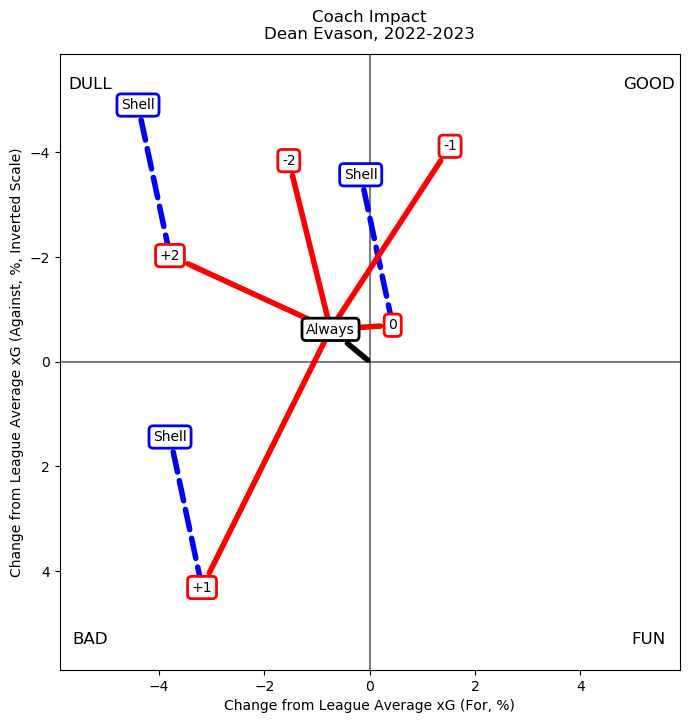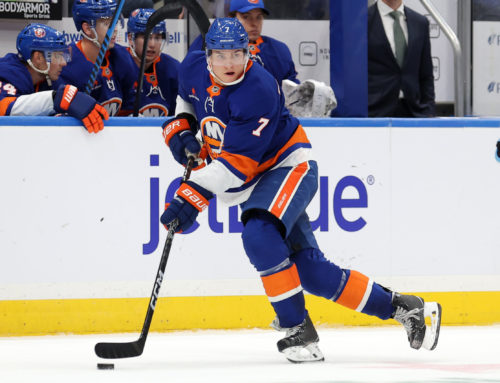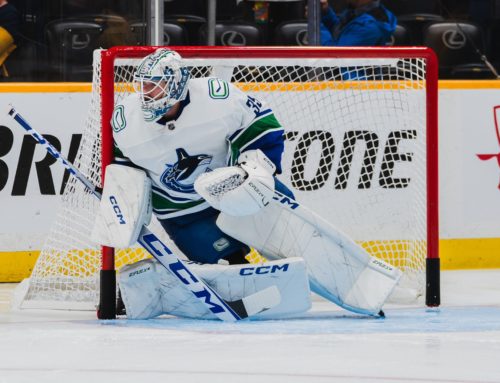The 2023-24 Dobber Hockey Fantasy Guide is set to release on Monday, so we are just a few days away from the big drop! The Guide is available for pre-order now in the Dobber Shop, so head on over there to reserve your copy now. Because it's all-digital, the Guide will be updated through to the beginning of the season to reflect trades/signings, injuries, line combinations, and more. It will have depth charts, projections, prospect news, and a slew of articles like rebounds, drop-offs, sleepers, and a whole lot more. Help support what we do year-round and make sure you have a head start on all your league mates.
*
In yesterday's Ramblings, Alex wrote about Columbus hiring Dean Evason as their head coach. I encourage readers to check out what he had to say there.
One thing I will note is something I saw when perusing the HockeyViz site. That site has a section on coaching impact as it relates to expected goals for and expected goals against at different goal states (leading, trailing, up two goals, down two goals and so on). What stuck out to me is that while strategies changed over the last few seasons, the Minnesota Wild frequently locked things down defensively.
In 2021-22, the Wild were around league average or better by expected goals against regardless of the state of the game (trailing or leading). In 2022-23, the same was true except when leading by one:

There isn't much of a sample for Evason in 2023-24 because he was fired about six weeks into the season, but the Wild were a team that excelled defensively almost regardless of whether they had the lead or were chasing it. If there is one thing Columbus really needs to work on, it's their defensive game, and if he can help that, it'll be a big boost to their goaltending. There is a long way for that team to go until they get competent in this regard, but if they can stay healthy, I wouldn't dismiss the potential for a significant, immediate upgrade defensively. Keep that in mind when looking for late-round goaltenders in fantasy drafts.
*
In my Ramblings on Tuesday, we looked at changes in peripheral fantasy stats like shots, hits, blocks, and penalty minutes. Knowing where we've been, and what targets should be for fantasy owners, is important when heading into a new season.
Today, we'll move along to the main event, and that's point production. We will look at goals, total assists, first/second assists, and how all this relates to both the power play and short-handed offence. As usual, we will be getting the data from either Natural Stat Trick or Frozen Tools. We will be getting some additional data from Hockey Reference as well. We're going to look at all players, but in Friday's Ramblings we are going to start splitting things by forwards and defencemen again like we did with peripherals.
The first note is that goal scoring across the league fell to 3.11 goals per team per game. That is a three-year low and represents a total drop of nearly 2%. That isn't a huge margin, but it does mean over 160 fewer goals across the league overall.
How those goals were distributed also matters because not every player is relevant for fantasy purposes. Here are the different levels of goal-scoring from each of the last three seasons at all strengths:
| Range | 2021-22 | 2022-23 | 2023-24 |
| Under 20 Goals | 867 | 822 | 785 |
| 20-29 Goals | 86 | 75 | 92 |
| 30-39 Goals | 34 | 35 | 30 |
| 40-49 Goals | 13 | 14 | 13 |
| 50+ Goals | 4 | 5 | 4 |
Despite fewer goals scored than either of the last two seasons, the number of players to score at least 40 goals in 2023-24 (17) was the same number as 2021-22 (17). Also, there were more players to score at least 20 goals in 2023-24 (139) than either of the prior two seasons (129 and 137, respectively). There was a modest change in the number of players to score at least 30 goals, and that area is drying up a little bit, but there were more players to manage at least 20 goals, and that's a good barometer for fantasy relevance.
Each goal can have up to three components, and that's goals, assists, and secondary assists. When we look at a drop in goal scoring of 1.9% across the league when compared to 2022-23, it gives us a benchmark to look at when considering total point production. Here is how goals, first assists, and second assists have change over the last three seasons:
| 2021-22 | 2022-23 | YoY %Change | 2023-24 | YoY %Change | |
| Goals | 8150 | 8247 | +1.2% | 8074 | -1.9% |
| 1st Assists | 7632 | 7705 | +0.9% | 7548 | -2% |
| 2nd Assists | 6152 | 6186 | +0.5% | 6067 | -1.9% |
So, there isn't much to glean from this. The changes from 2022-23 to 2023-24 in terms of first and secondary assists drops are pretty much in line with the drop in goals from year to year. I thought there might be a case of fewer secondary assists being handed out, but that certainly hasn't been the case. It would be more interesting to look at the difference in changes between goals, first assists, and second assists from 2021-22 to 2022-23, but that's not really relevant for us right now.
One fun little wrinkle: in both 2021-22 and 2022-23, there were 31 players to reach at least 50 assists. In 2023-24, with a three-year low in goals cored, there were 34 players to reach at least 50 assists. Remember that in Tuesday's Ramblings, we found that the elite shot-takers weren't being affected by total shot drops across the league. Similarly, it seems like the drop in goals across the NHL hasn't really affected the upper class of players with high-end assist totals.
What is of most interest to us should be power play scoring. Power play goal scoring in 2023-24 was down from 2022-23, but up from 2021-22. How that affects league scoring, and what point production levels players are reaching, is very important for us to figure out.
Here are the goal and assist totals with the man advantage over the last three seasons, and percentage changes year-over-year from 2021-22 to 2022-23, and from 2022-23 to 2023-24:
| 2021-22 | 2022-23 | YoY %Chg | 2023-24 | YoY %Chg | |
| Goals | 1567 | 1716 | +9.5% | 1665 | -3% |
| Assists | 3030 | 3266 | +7.8% | 3170 | -2.9% |
There really wasn't much of a difference between the drop in goals and the drop in assists last season from the one prior. The interesting part is there were as many players to reach double-digit power play goals in 2023-24 as the year before (42). Despite a drop in goal scoring, players with high-end power play goal totals remained unchanged. The number of players with at least 20 power play goals dropped precipitously from five to just two, but the number of players with very fantasy relevant PP goal totals was the same. The middle class in NHL power play goal scoring is thriving.
In another area of particular interest for me personally, I wanted to see if there were any relevant short-handed goal changes. Penalty kills have gotten a lot more aggressive over the last half-decade, and how much that translated to goal scoring is of importance to fantasy owners. So, here are the changes in goals and assists while short-handed over the last three seasons.
| 2021-22 | 2022-23 | YoY %Chg | 2023-24 | YoY %Chg | |
| Goals | 211 | 246 | +14.2% | 234 | -4.9% |
| Assists | 242 | 273 | 12.8% | 241 | -11.7% |
Short-handed goals have certainly gone up over the last couple of seasons overall, even if there was a drop from 2022-23 to 2023-24. What is interesting here is that despite 23 more PK goals scored in 2023-24 when compared to 2021-22, there was one (1) fewer assist. I think that is where the aggression is coming into play; there are more breakaways leading to goals, but that type of play doesn't lend itself to more assists, necessarily.
Alright, let's put it all together. We are going to look at all strengths (AS) scoring, power play (PP) scoring, and short-handed (SH) goal scoring and assist production all in one chart:
| 2021-22 | 2022-23 | 2023-24 | |
| AS Goals | 8150 | 8247 | 8074 |
| PP Goals | 1567 | 1716 | 1665 |
| SH Goals | 211 | 246 | 234 |
| AS Assists | 13784 | 13891 | 13615 |
| PP Assists | 3030 | 3266 | 3170 |
| SH Assists | 242 | 273 | 241 |
Now, to see what share of goals are scored on special teams, and how that can inform us as we prepare for fantasy drafts:
| 2021-22 | 2022-23 | 2023-24 | |
| % Goals on PP | 19.2% | 20.8% | 20.6% |
| % Assists on PP | 22% | 23.5% | 23.3% |
| % Goals SH | 2.6% | 3.0% | 2.9% |
| % Assists SH | 1.8% | 2% | 1.8% |
There is an adage going around that the NHL is a special team league now, and it's not hard to see why that is the case. Last season, nearly one in four goals was scored either on the power play or the penalty kill, and that means roughly 1900 goals scored on special teams. While even strength play clearly drives a significant portion of the play still, the prevalence of special teams tallies cannot be disregarded or minimized. Every two games, roughly three goals will be scored either on the PP or PK and overlooking that much production is a perilous approach.
We don't want to overstate it, but in 2021-22, roughly 21.8% of all goals were scored on special teams. This past season, that number was 23.5%. That is a relative increase of about 8%, and that's important. We should also mention that the jump in assists on special teams has been over 25% of all assists in both of the last two seasons. With those categories sometimes being used in more complex multi-cat fantasy formats, it's important to note these small changes.
Alright, that will do it for today. Again, we'll look at forward/defence splits in tomorrow's Ramblings.





 FLA
FLA CHI
CHI NYR
NYR PIT
PIT L.A
L.A COL
COL MTL
MTL CAR
CAR CBJ
CBJ NSH
NSH PHI
PHI UTA
UTA BOS
BOS
